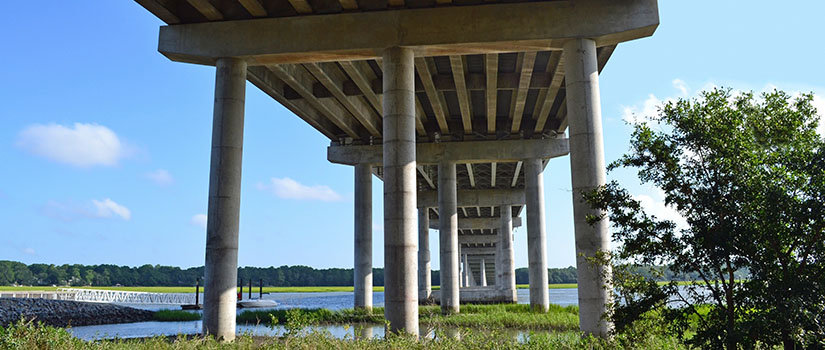South Carolina continues to experience minor earthquakes, more than 140 years after the 7.3 magnitude Charleston earthquake of 1886 killed more than 100 and damaged hundreds of buildings. Another major seismic event has the potential to be more catastrophic than the 1886 earthquake due to population growth and a more extensive transportation infrastructure.
The Molinaroli College of Engineering and Computing is currently leading efforts and collaborating with the South Carolina Department of Transportation (SCDOT) to ensure the state’s bridges are resistant to damage from future earthquakes.
Civil and Environmental Engineering (CEE) Department Chair Juan Caicedo and Associate Professor Inthuorn Sasanakul are leading a $1.5 million, four-year project funded by the SCDOT to revise the Seismic Design Specifications (SDS) for highway bridges. The SDS policy and procedures were developed by the SCDOT in 1996 and last revised in 2008.
The transportation infrastructure is critical for recovery after a significant seismic event, but without proper engineering design, widespread damage would cripple the state. Required design of bridges based on the latest literature and knowledge is essential, and bringing statewide bridges up to a particular performance level must first be evaluated.
The current project, which began last August, also aims to improve the performance-based design approach. The results will provide a design philosophy that includes the appropriate performance criteria for bridges. The research group is working on how they can reevaluate the safety of bridges and develop methods to spend less without compromising safety. This includes examining the probabilities of earthquakes occurring and damage as well as design specifications based on the life of a bridge.
“There must be a balance between the safest design for bridges at an affordable cost. We cannot design bridges to survive every earthquake because it’s fiscally impossible,” Caicedo says.
According to alumna Mabel Cuellar, Ph.D. ’16, geostructural engineer for SCDOT, manuals, specifications and standards help control the level of quality and performance of the state’s transportation infrastructure.
“These documents are dynamic, and they need to be revised periodically to adopt the most recent developments within the transportation field,” Cuellar says. “Updating the SCDOT Seismic Design Specifications allows the agency to incorporate the newest research on earthquake engineering and present opportunities to address different parameters that influence the seismic design of bridges.”
The research group is currently working on numerical models, including higher resolution models to better understand the interaction between a bridge’s foundation and soil. The models will help perform a risk assessment analysis to account for seismic hazards based on a bridge’s location and soil conditions. A risk assessment involves calculating the probability that a bridge will fail.
“With a risk assessment, we can evaluate if the risk of failure is appropriate or if needs to be changed,” Caicedo says. “Then we’ll try to extrapolate what will happen with bridges around the state and make decisions about how the manual should be written.”
During the project’s first year, some bridges have been used as examples to model in a more defined manner with available resources. This will eventually lead to simulations which will help determine the type of damage based on the size of the earthquake and how changing a specific part of a bridge’s structure can affect the damage.
“For example, if an earthquake happens in Charleston, then what is the probability that a bridge designed with the current specifications will fail? And what is the probability that they will fail if we change the way they are designed,” says Caicedo.
Sasanakul’s expertise is in geotechnical engineering, a sub-discipline focused on the behavior of soil and natural material in the ground. Bridges and other structures often collapse during earthquakes because of the type of soil below the foundation.
“The soil is equally as important as the structure itself because the bridge’s foundation comes from the ground,” Sasanakul says. “When there's an earthquake, it spreads through the soil and shakes the ground, which will move at a certain degree. Soil and structure interaction is complicated but important.”
Sasanakul admits that determining how the soil will move is a challenging process because of variables between bridges and a lack of data. And since several varieties of soil are found across the state, it can make the layering behavior more challenging. However, progress has been made in geotechnical earthquake engineering since 2008, and the new knowledge will be incorporated into the risk assessment to update the manual.
“For example, there is more data now about the soil in different areas of the state. This is also helpful on structural interaction and how we handle different situations, especially a worst-case scenario such as a big earthquake,” Sasanaukul says.
The project includes faculty from the University of South Carolina, Clemson, and The Citadel. When Caicedo’s group begins writing the manual next year, CEE faculty Fabio Matta and Sarah Gassman will be more involved. Matta has previous experience writing design manuals, and Gassman has expertise on buried structures and the effect of soil aging. Once the manual is complete, the SCDOT will determine whether the level of damage is appropriate.
“They might agree with our assessment or decide that we need to make it more resistant to earthquakes. They may also determine that we don’t need as strong a design because the probability of failure might not be as high as originally thought,” Caicedo says.
Field data collected from recent earthquakes throughout the state have led to advances in earthquake engineering and research, and the research team looks forward to updating the SDS to address the needs and requirements of the SCDOT.
“I'm excited to see how the risk assessment turns out,” Caicedo says. “Since we're using newer methodologies from 2008, it will be interesting to see how they match. It will also be interesting to see how the document is put together after conversations with the DOT, industry and people from other states.”
